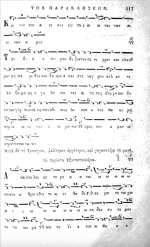Most would agree that the Megalynarion "Speechless be the lips" is chanted slowly and melodiously as the Bishop descends from his throne to reverence the icon of the Theotokos; he then blesses the people, while the Choir chants "Many years, master," and returns to his throne as the Megalynarion of the Saint to whom the temple is dedicated and the final Megalynarion "O all ye arrays of Angelic Hosts" are chanted.
In this article, Bishop Basil of the Antiochian Archdiocese writes:
In the Anastasimatarion by Constantine the Protopsaltis (1865), which contains music for the Paraklesis service by Panagiotes Kiltzanides, the following note is given:
Also, should the Slow Heirmologic version of the Megalynarion "Speechless be the lips" ever be chanted when the Bishop is not presiding? I do not think it should, since the purpose of chanting the Slow Heirmologic version is only to cover the liturgical action of the Bishop reverencing the icon.
In this article, Bishop Basil of the Antiochian Archdiocese writes:
Does anyone have a source for this? Is this done anywhere today?But when the exaposteilaria are chanted at the end of the service, as all during the Dormition Fast, the bishop does not reverence the icon of the Theotokos during the chanting of the megalynaria, but during the chanting of the third exaposteilarion "I have thee as Mediatress" (p. 300); he then blesses the people while the choir chants "Many years, master," and returns to his throne as the final exaposteilarion "Thou art a gold-entwined tower" (p. 300) is chanted.
In the Anastasimatarion by Constantine the Protopsaltis (1865), which contains music for the Paraklesis service by Panagiotes Kiltzanides, the following note is given:
So some direct that the veneration should occur when "Accept thou mine entreaty and my poor prayer" (i.e., the last Troparion of the Ninth Ode of the Canon, before "It is truly meet") is being chanted. Is this done anywhere today?Ωδε ασπάζεται ο Δεσπότης τὴν ̔Αγίαν Εικόνα τής Ὑπεραγίας Θεοτόκου. Ετέρα γνώμη. Ὁ ασπασμὸς νὰ γίνηται όταν ψάλλεται τὸ, Τὴν δέησίν μου δέξαι τὴν πενιχράν.
Also, should the Slow Heirmologic version of the Megalynarion "Speechless be the lips" ever be chanted when the Bishop is not presiding? I do not think it should, since the purpose of chanting the Slow Heirmologic version is only to cover the liturgical action of the Bishop reverencing the icon.
Last edited:

